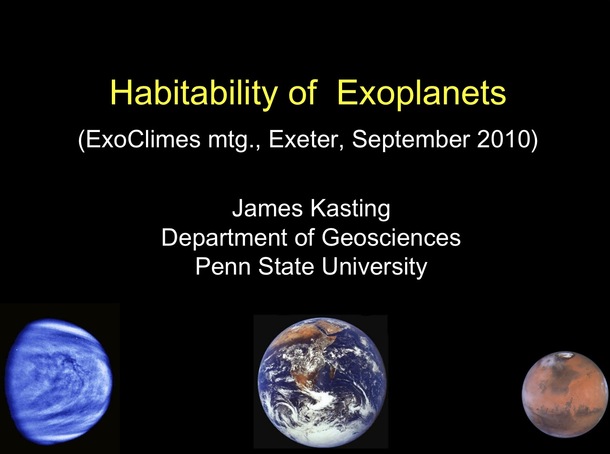Living planets > James Kasting

If initial loading stalls, switch to the Flash version.
Habitability of exoplanets
James Kasting
Pennsylvania State University, USA
Help



Abstract: In order to be considered habitable by terrestrial standards, an exoplanet must lie within the conventional habitable zone (HZ) around its parent star, defined as the region where liquid water is stable at the planet’s surface. Other types of planets – for example, those with subsurface liquid water - might be habitable; however, it would be difficult to detect life remotely on such planets, and hence they are of limited interest. Our models of the HZ have remained more or less the same for almost 20 years. They are defined for Earth-like planets with N2-CO2-H2O atmospheres. The inner edge of the HZ is defined by loss of water, either by a runaway greenhouse, or by a variant thereof termed a ‘moist greenhouse’. The outer edge is defined by the distance at which CO2 begins to condense on a planet’s surface. All calculations thus far have been done with 1-D climate models. Improved 3-D climate models for addressing this question are still in development. Some authors have published HZ models that depend more strongly on the nature of the planet. Such models, however, can only be applied if the planet’s characteristics have already been determined, and so they are of limited utility for guiding future searches. Although this theory of the HZ is attractive, it may well be over- simplified, as it does not seem to account for the climates of either early Earth or early Mars. Mars looks as if it was habitable early in its history, yet it falls outside of the Kasting et al. (1993) boundaries. Attempts to explain the warmth of early Mars by adding additional greenhouse gases to its atmosphere have for the most part been unsuccessful (as have models in which early Mars was generally cold). Early Earth was well within the published HZ boundaries; however, past CO2 concentrations derived from paleosols and, more recently, from banded iron-formations are significantly lower than those required to compensate for the reduced luminosity of the young Sun. Additional surface warming could have been provided by reduced greenhouse gases, including both CH4 and NH3, by enhanced pressure-broadening by N2, or by cloud albedo feedbacks. An attempt will be made to sort out this confusion and to explore the implications for the prospects of finding habitable planets elsewhere.
Additional materials: PDF of slides
ExoClimes 2010, Exeter, Friday 10th Sep 2010
Additional materials: PDF of slides
ExoClimes 2010, Exeter, Friday 10th Sep 2010
